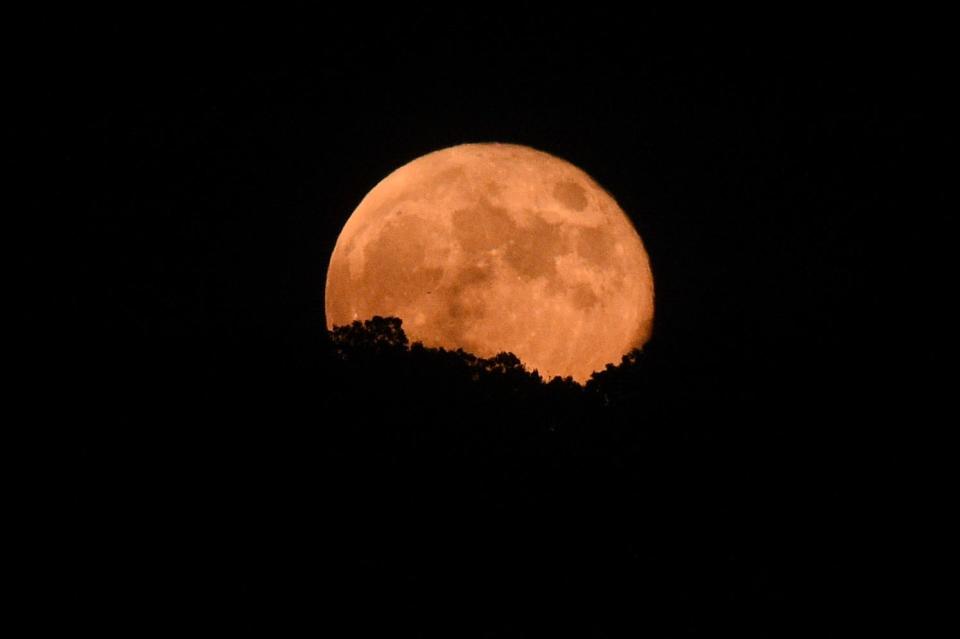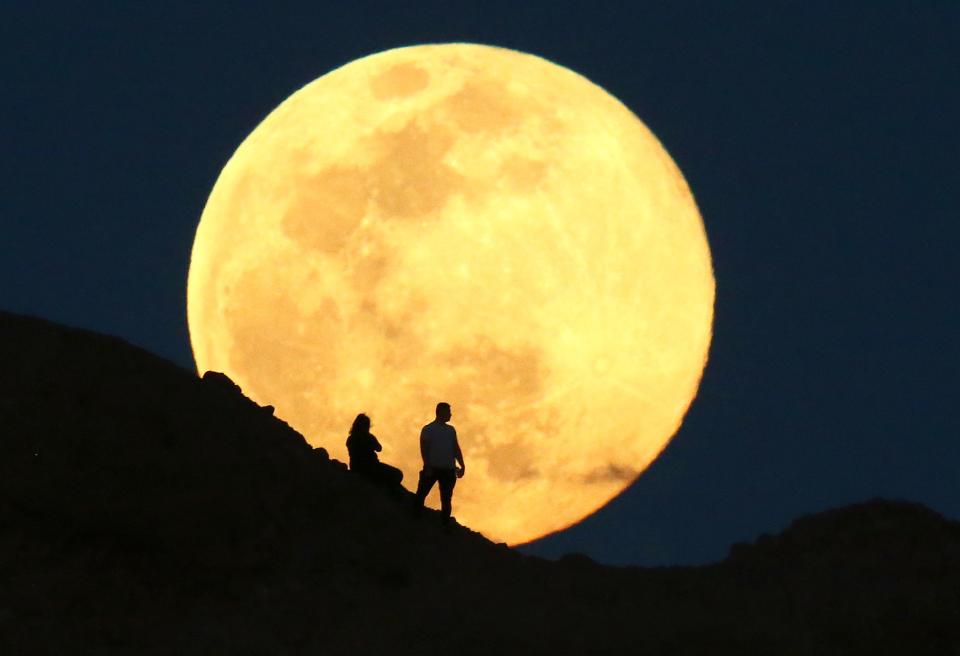Full moons of 2024: Dates and meaning of their names
The first full moon of 2024 will happen in just under three weeks, but do you know what that full moon is called? It's the Wolf Moon and will be rising on Jan. 25.
The 12 full moons each year are named by Native Americans, according to the Old Farmer's Almanac. UNC Asheville Associate Professor of Astronomy Britt Lundren told the Times-News Jan. 5 that full moons occur approximately every 29.5 days.
"The period of the lunar phases, which astronomers refer to as a syndoic month, is caused by the orbit the moon makes around the Earth. As the moon moves in its orbit, the relative position of the sun illuminates different fractions of the lunar surface, as seen from the Earth," she said.

"A full moon occurs each time the moon is located on the opposite side of the Earth, relative to the sun. During this time we on the Earth see its maximum surface illuminated."
As far as the full moon names, Lundren said when sharing common Native American names throughout the year, it’s important to acknowledge the cultural diversity of the tribes across Turtle Island (also known as North America).
More: Full moon on Christmas Day? What to know about the 'Long Night Full Moon' of 2023
"Each tribe has a close relationship with the land, and their moon names will reflect the seasonal changes unique to their environments," she said.
Below is a list of the full moons in 2024, their dates, their names and why they were given that particular name, according to the Almanac:
Wolf Moon on Jan. 25
Why this name: The howling of wolves was often heard at this time of year. Many sources state that wolves howled due to hunger. Rather, wolves use howls to define territory, locate pack members, reinforce social bonds and gather for hunting.
Alternate names:
• Canada Goose Moon (Tlingit)• Center Moon (Assiniboine)• Cold Moon (Cree)• Freeze Up Moon (Algonquin)• Frost Exploding Moon (Cree)• Great Moon (Cree)• Greetings Moon (Western Abenaki)• Hard Moon (Dakota)• Severe Moon (Dakota)• Spirit Moon (Ojibwe)
More: Students and astronomy club members view Asheville's Oct. 14 eclipse. What did they see?
Snow Moon on Feb. 24
Why this name: February is typically a time of heavy snowfall.
Alternate names:
• Bald Eagle Moon (Cree)• Bear Moon (Ojibwe)• Black Bear Moon (Tlingit)• Month of the Bony Moon (Cherokee)• Eagle Moon (Cree)• Goose Moon (Haida)• Groundhog Moon (Algonquin)• Hungry Moon (Cherokee)• Raccoon Moon (Dakota)
Worm Moon on March 25
Why this name: Traditionally thought to be named after the earthworms of warming spring soil. Alternatively, in the late 1700s, Jonathan Carver wrote that this moon actually refers to a different sort of “worm” — larvae — which emerge from the bark of trees and other winter hideouts around this time.
Alternate names:
• Crow Comes Back Moon (Northern Ojibwe)• Eagle Moon (Cree)• Goose Moon (Algonquin, Cree)• Snow Crust Moon (Anishinaabe)• Sore Eyes Moon (Dakota, Lakota, Assiniboine)• Sugar Moon (Ojibwe)• Wind Strong Moon (Pueblo)

Pink Moon on April 23
Why this name: This full moon heralded the appearance of the “moss pink,” or wild ground phlox — one of the first spring wildflowers.
Alternate names:
• Breaking Ice Moon (Algonquin)• Broken Snowshoe Moon (Anishinaabe)• Budding Moon of Plants and Shrubs (Tlingit)• Frog Moon (Cree)• Moon of the Red Grass Appearing (Oglala)• Moon When the Ducks Come Back (Lakota)• Moon When the Geese Lay Eggs (Dakota)• Moon When the Streams are Again Navigable (Dakota)• Sucker Moon (Anishinaabe)• Sugar Maker Moon (Western Abenaki)
Flower Moon on May 23
Why this name: Flowers spring forth in abundance this month.
Alternate names:
• Budding Moon (Cree)• Egg Laying Moon (Cree)• Frog Moon (Cree)• Leaf Budding Moon (Cree)• Planting Moon (Dakota, Lakota)• Moon of Shedding Ponies (Oglala)
Strawberry Moon on June 21
Why this name: This was the time to gather ripening strawberries in what is now the northeastern United States.
Alternate names:
• Berries Ripen Moon (Haida)• Birth Moon (Tlingit)• Blooming Moon (Anishinaabe)• Egg Laying Moon (Cree)• Hatching Moon (Cree)• Green Corn Moon (Cherokee)• Hoer Moon (Western Abenaki)
Buck Moon on July 21
Why this name: Now, a buck’s (male deer’s) antlers are in full growth mode.
Alternate names:
• Berry Moon (Anishinaabe)• Feather Moulting Moon (Cree)• Halfway Summer Moon (Anishinaabe)• Month of the Ripe Corn Moon (Cherokee)• Moon When the Chokecherries are Ripe (Dakota)• Raspberry Moon (Algonquin, Ojibwe)• Salmon Moon (Tlingit)• Thunder Moon (Western Abenaki)
Sturgeon Moon on Aug. 19
Why this name: The Great Lakes and Lake Champlain sturgeon were said to be most readily caught during this full moon.
Alternate names:
• Black Cherries Moon (Assiniboine)• Corn Moon (Algonquin, Ojibwe)• Flying Up Moon (Cree)• Harvest Moon (Dakota)• Mountain Shadows Moon (Tlingit)• Ricing Moon (Anishinaabe)
Harvest Moon on Sept. 17
Why this name: This is the full moon that occurs closest to the autumnal equinox. In 2024, this occurs in September. This time also corresponds with the traditional harvesting of corn.
Alternate names:
• Autumn Moon (Cree)• Child Moon (Tlingit)• Corn Harvest Moon (Dakota)• Corn Maker Moon (Western Abenaki)• Falling Leaves Moon (Ojibwe)• Leaves Turning Moon (Anishinaabe)• Mating Moon (Cree)• Moon of Brown Leaves (Lakota)• Moon When the Rice is Laid Up to Dry (Dakota)• Rutting Moon (Cree)• Yellow Leaf Moon (Assiniboine)
Hunter's Moon on Oct. 17
Why this name: This is the month when game is fattened up for winter. Now is the time for hunting and laying in a store of provisions for the long months ahead.
Alternate names:
• Drying Rice Moon (Dakota)• Falling Leaves Moon (Anishinaabe)• Freezing Moon (Ojibwe)• Ice Moon (Haida)• Migrating Moon (Cree)
Beaver Moon on Nov. 15
Why this name: This was the time when beavers finished preparations for winter and retreated into their lodges.
Alternate names:
• Deer Rutting Moon (Dakota, Lakota)• Digging/Scratching Moon (Tlingit)• Freezing Moon (Anishinaabe)• Frost Moon (Cree, Assiniboine)• Whitefish Moon (Algonquin)
Cold Moon on Dec. 15
Why this name: This is the month when the winter cold fastens its grip, and the nights become long and dark.
Alternate names:
• Drift Clearing Moon (Cree)• Frost Exploding Trees Moon (Cree)• Hoar Frost Moon (Cree)• Little Spirit Moon (Anishinaabe)• Long Night Moon (Mohican)• Mid-winter Moon (Lakota, Northern Ojibwe)• Moon of the Popping Trees (Oglala)• Moon When the Deer Shed Their Antlers (Dakota)• Snow Moon (Haida, Cherokee)• Winter Maker Moon (Western Abenaki)
Dean Hensley is the news editor for the Hendersonville Times-News. Email him with tips, questions and comments at DHensley@gannett.com. Please help support this kind of local journalism with a subscription to the Hendersonville Times-News.
This article originally appeared on Hendersonville Times-News: Dates, meaning of names of the 12 full moons of 2024

